Transport in Botswana
Transportation in Botswana is provided by internal and extensive network of railways, highways, ferry services and air routes that criss-cross the country.[1]

Rail transport
Railways
BR Express
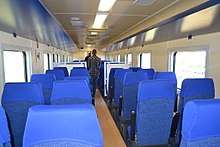
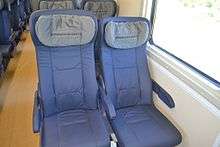
All passenger services were discontinued in 2009, with the only remaining service being an international link to Zimbabwe from Francistown. Freight trains still operate. Passenger service was expected to resume in late 2015.[2] Passenger services were later re-introduced in March 2016.
Freight trains
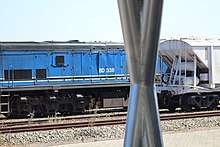
Over half of BRs freight traffic is in coal, grain and intermodal freight, and it also ships automative parts and assembled automobiles, sulphur, fertilizers, other chemicals, soda ash, forest products and other types of the commodities.
Regional trains
Botswana Railways run 2 nightly passenger trains, one from Lobatse to Francistown, and the other from Francistown to Lobatse, with stops in Gaborone, Mahalapye, Palapye, and Serule. The passenger train is termed the "BR Express" (Botswana Railways).
Commuter/Suburban trains
In Botswana, the (Botswana Railways) "BR Express" has a commuter train between Lobatse and Gaborone. The train is scheduled to depart in Lobatse at 0530hrs and arrive at Gaborone 0649hrs. This train return to Lobatse in the evening, well departing in Gaborone at 1800hrs. Arrival time at Lobatse is 1934hrs.
BR Express Sleeping & Dining Department
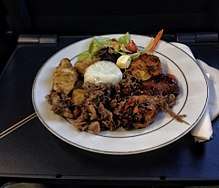
The BR decided from the very beginning that it would operate its own sleeping cars. Bigger - sized berths and more comfortable surroundings were built. Providing and operating their own cars allowed better control of the service provided as well as revenue received, although profit was never a direct result of providing food to passengers. Rather, it was for those who could afford to travel great distances expected such facilities and favourable opinion would - well attracting others to Botswana and the BR's trains.
Locomotives

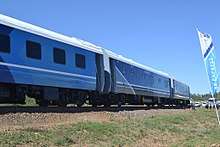
Diesel locomotives
As of March 2009
- 8 General Electric UM 22C diesel-electric locomotive, 1982.
- 20 General Motors Model GT22LC-2 diesel-electric locomotive, 1986.
- 10 General Electric UI5C diesel-electric locomotive, 1990.
8 new gt142aces delivered in 2017 from emd.
Network
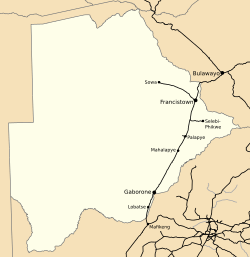
- total: 888 km (since 2015)[3]
- number of stations: 13
- standard gauge: 1,067 mm (3 ft 6 in) cape gauge.
Railway links with adjacent countries
Existing
South Africa-yes- same gauge 1,067 mm (3 ft 6 in)
Zimbabwe-yes- same gauge 1,067 mm (3 ft 6 in)
Currently under construction
Zambia- being built at Kazungula Bridge in Kazungula.
Proposed
Road transport
Vehicle Population
- Botswana had 584,000 locally registered vehicles at the end of June 2019[4] - more than double the number from 10 years ago. This equates to around 250 vehicles per 1,000 people in the country.
- 30,583 vehicles were registered in the first 6 months of 2019.
- Second hand imports from Asia (and the UK) are a significant source of vehicles in Botswana.
Highways
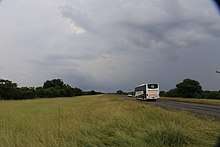

- As of 1996, Botswana has 10,217 km of highway.
Roads;
- total; 10,217 km
- paved; 5,620 km
- unpaved; 4,597 km (1996 est.)
Existing highways
Motorways
FEATURES
REGULATIONS
Motorways in Botswana have a set of restrictions, which prohibit certain traffic from using the road. The following classes of traffic are not allowed on Botswana motorways:
- Learner drivers
- Slow vehicles (i.e. not capable of reaching 60 km/h on a level road).
- Invaild carriages (lightweight three-wheeled vehicles)
- Pedestrians
- Pedal-cycles (bicycles, etc.)
- Vehicles under 50cc (e.g. mopeds)
- Tractors
- Animals
Rules for driving on motorways include the following:
- The keep-left rule applies unless overtaking
- No stopping at any time
- No reversing
- No hitchhicking
- Only vehicles that travel faster than 80 km/h may use the outside lane
- No driving on the hard-shoulder
Road Sign
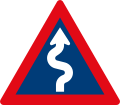

Traditionally, road signs in Botswana used blue backgrounds rather than the yellow, white, or orange that the rest of the world uses on traffic warning signs. In the early 2010s, officials announced plans to begin phasing out the distinctive blue signs in favor of more typical signs in order to be more in line with the neighboring Southern African Development Community member states.[6]
Interchanges
Existing
- Thapama Interchange at the junction of A1 / Blue Jacket Street and A3 in Francistown.[7][8]
- Boatle Interchange in Boatle.
Under-construction
The Government of Botswana is building three (3) interchanges along K.T Motsete Drive (Western Bypass) in Gaborone. This project started on August 2019, and deadline date is set 2021.
Longest Bridges
Botswana will have two (2) longest bridges by span and the following are:
Under construction

- Kazungula Bridge in Kazungula.
- Mohembo Bridge located in Mohembo.
Roadway links with adjacent countries
Existing
Mass Transit
Taxiscab
In most parts of Botswana, there are many taxiscabs of various colours and styles. Botswana has no limitation in taxicab design, so each taxiscab company adopts their own design.
Minibus Taxis
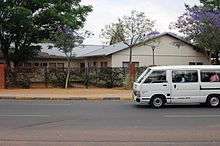
Minibus Taxis is also known as Kombi are the predominant form of transport for people in urban areas of Botswana and mostly of them they're found within cities, towns, major villages and even least populated areas.
They also have their own minibus station within that particular area, they only transport people within that specific area, and all of them they have different routes. This is due to their availability and affordability to the public.
Most minibus taxis they do not have depart time that's allocated by the state and mostly of them they have 15 seaters. Currently, they're owned by many minibus owners.
Coach Bus
Coach buses are used for longer-distance services within and even outside Botswana. They're normally operated by private companies and they're the only ones that have depart time that's allocated by the ministry of transport.
All couch buses have different time for depart and they also have different routes, and they also have their couch bus stations all over Botswana.
Aviation
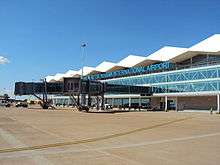
In 2004 there were an estimated 85 airports, 10 of which (as of 2005), were paved. The country's main international airport is Sir Seretse Khama International Airport in Gaborone. The government-owned Air Botswana operates scheduled flights to Francistown, Gaborone, Maun, and Selebi-Phikwe. There is international service to Johannesburg, South Africa; Mbabane, Swaziland; and Harare, Zimbabwe. A new international airport near Gaborone was opened in 1984. Air passengers arriving to and departing from Botswana during 2003 totalled about 183,000.
International Airports
Botswana has 4 international airports. The following are:
Existing
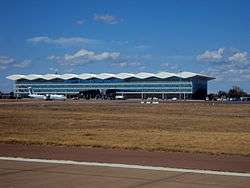
- Francistown Airport in Francistown.
.jpg)
- Kasane Airport in Kasane.
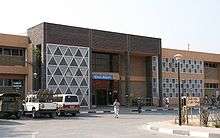
- Maun Airport in Maun.
Proposed
- "Mophane International Airport" is yet to be established in Palapye Sub-District near Moremi village.
Pipelines
Currently under construction
North-South Carrier
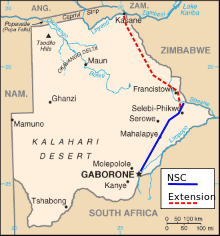
NSC is a pipeline in Botswana that carries raw water, south for a distance of 360 kilometres (220 mi) to the capital city of Gaborone. It was done in phases. However, phase 1 was completed in 2000.
Phase 2 of the NSC, still under construction, will duplicate the pipeline to carry water from the Dikgatlhong Dam, which was completed in 2012.
A proposed extension to deliver water from the Zambezi would add another 500 to 520 kilometres (310 to 320 mi) to the total pipeline length.
Lesotho-Botswana Water Transport
The Lesotho-Botswana Water Transfer is a project which is expected to provide Two Hundred Million Cubic Meters per year, to transfer water to the South-Eastern parts of Botswana is also ongoing.
The scheme involves the supply of water to Gaborone from Lesotho via a Six to Seven Hundred kilometer 600 to 700 kilometres (370 to 430 mi) pipeline.
The project commenced on the 1 August 2018 and is set for completion in June, 2020.
Proposed
Sea Water Desalination Project
The Government of Botswana intends to sign the Sea Water Desalination Project from Namibia. The project is at a tendering stage.
Water transport
Waterways
Ferries
_from_Botswana_to_Zambia_-_panoramio.jpg)
Kazungula Ferry is a pontoon ferry that crosses 400 metres (1,300 ft) wide Zambezi River between Botswana and Zambia.
Border Posts
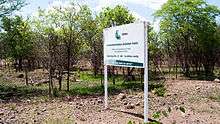
- Bokspits Border Post
- Kazungula Border Post
- Ramatlabama Border Post
- Ramokgwebana Border Post
- Mamuno Border Post
- Pandamatenga Border Post
Infrastructure
Pedestrian Elevated Walkway
Botswana has many pedestrian elevated walkways at different places.

Tour Boats

See also
External links
| Wikimedia Commons has media related to Transport in Botswana. |
References
- Mupimpila, C (2010-09-30). "Internalising the Externalities of Public Transport in Botswana". Botswana Journal of Economics. 5 (7). doi:10.4314/boje.v5i7.60307. ISSN 1810-0163.
- Passenger train is coming back, Tue 09 Dec 2014, Mmegi Online, http://www.mmegi.bw/index.php?aid=47955 Archived 2015-02-26 at the Wayback Machine
- "Figure 7.13. Total Length of Rail Network/ Country Area". doi:10.1787/806740202414. Cite journal requires
|journal=(help) - "Vehicle population nears 600,000". MmegiOnline. Mmegi. Retrieved 1 November 2019.
- "ROADS AND RAILWAYS: Botswana". Africa Research Bulletin: Economic, Financial and Technical Series. 53 (3): 21217C–21219A. 2016-04-27. doi:10.1111/j.1467-6346.2016.07003.x. ISSN 0001-9852.
- "Mmegi Online" staff writer Maranyane Ngwanaamotho (Dec 21, 2011). "Old road signs are being phased out". Archived from the original on November 29, 2012. Retrieved Oct 5, 2012.
- Ketumile, Kesentse (Jan 25, 2016). "Hello spaghetti, bye bye traffic circles". Botswana Daily News. Archived from the original on 2016-10-14. Retrieved Oct 4, 2016.
- "Francistown Spaghetti Junction Opens for Public Use". The Midweek Sun. Dec 16, 2016. Retrieved Oct 4, 2017.